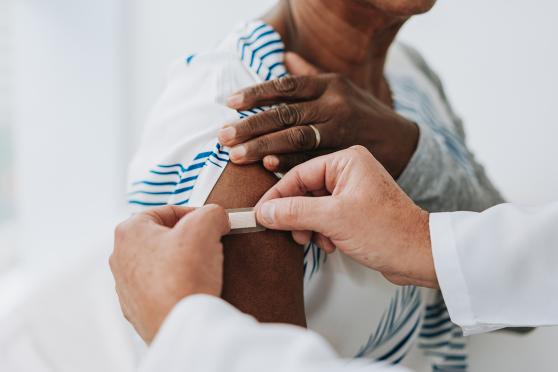Understand your COPD medications to breathe easier
Don’t let COPD rule your life. Know the facts about how your prescriptions can help you breathe better and learn tips for sticking to your medication schedule.

If you’ve been diagnosed with chronic obstructive pulmonary disease (COPD), you know how uncomfortable the condition can be. Fortunately, there are medications that can help ease symptoms like coughing, wheezing, and shortness of breath. The trick: taking them as instructed by your doctor.
The types of medications your doctor prescribes will depend on your symptoms and how often they flare up. Here’s an overview of some of the most common COPD treatments, plus advice for getting the most out of them.
Common COPD treatments
Bronchodilators
Used to control or reduce the effects of COPD, bronchodilators are drugs used to relax the muscles around your airways and open them up so you can breathe easier. There are two types of bronchodilators:
- Short-acting bronchodilators: Sometimes called fast-acting or rescue inhalers, short-acting bronchodilators are used when symptoms first appear. They work for about four to six hours. Some short-acting bronchodilators ease symptoms within three to five minutes. If your symptoms don’t improve with treatment or get worse, call your doctor or health care provider. If you can’t catch your breath or if you have blueness of your lips or fingernail beds, a rapid heartbeat, chest pains, or confusion, seek immediate care.
- Long-acting bronchodilators: These are generally taken once or twice every day to help stop breathing problems before they start. They work for about 12 to 24 hours.
Most bronchodilators are taken using an inhaler. This is a handheld device that allows you to breathe in the medicine so it’s delivered to your lungs. Ask your care team to show you the right way to use your inhaler. Bronchodilators can also be given in the form of an oral pill.
Inhaled corticosteroids
If you have daily flare-ups, your doctor may prescribe an inhaled corticosteroid. Corticosteroids are steroids that help lower inflammation in the airways and improve lung function. Regular use can reduce how often you have flare-ups.
Inhaled corticosteroids are typically used daily. Your doctor might also prescribe a combination of an inhaled corticosteroid and bronchodilator.
Tips to get the most out of your medicine
Taking the right medicine at the right time can help you keep your COPD under control and avoid a trip to the hospital. Here are some simple tips for sticking to your medication schedule.
Pair your medicine with another habit. Everyone forgets to take their medication sometimes. Pairing your medications with a habit you already have can make it easier to remember. For example, plan to take your medicine at set times each day, such as while you’re brewing your morning coffee or making breakfast. Or give your pet a treat at the same time as you take your meds. You might forget, but they won’t. And when they beg for a treat, that’s your cue!
Give yourself reminders. Visual or audio cues can be helpful. One idea: Set alarms on your phone.
Ask about automating your refills. Many pharmacies provide text alerts or automatic refills to help make sure you always have your medicine on hand. You might also be able to set up mail or home delivery. Ask about bigger refills, too. Switching from a 30-day to a 90-day refill means lower odds that you’ll run out of your medication.
Don’t let the cost stop you. If you’re concerned about the price of your medication, ask about lower-priced versions. Generic brands generally are cheaper and work just as well. Or there might be another low-cost option to try.
Be aware of how you feel. If you notice that side effects from your medicine are getting in the way of daily life, talk to your doctor or health care provider. They might be able to change your prescription or dose to help you feel more comfortable.
Lifestyle habits that help you breathe easier
Medications are key to managing your COPD. But the right lifestyle habits can also lower your risk of flare-ups and help you feel better. Try these to start:
If you smoke, plan to quit. Long-term cigarette smoking is the biggest risk factor for COPD. E-cigarettes and vaping devices can also harm your lungs and make COPD worse. Smokefree.gov, from the National Institutes of Health, offers helpful resources for ending your smoking habit.
Practice pursed-lip breathing. This simple breathing exercise helps slow down breathing and improve breathing patterns. Start by breathing in slowly through your nose for two counts, keeping your mouth closed. Then pucker your lips as if you’re about to whistle and breathe out slowly for four counts.
Exercise regularly. Getting the right amount of exercise can be beneficial for those with COPD. In general, you should gradually work up to 20 to 30 minutes at least three to four times a week to achieve maximum benefits. Even a 20-minute walk once a day could make a difference. Staying active can improve how well your lungs work, but before starting an exercise program, check with your health care provider.
Avoid high or low temperatures. Heat and cold can make COPD symptoms worse. Also, keep track of air quality since that might affect your breathing, too.
When you combine taking your meds regularly with healthy lifestyle changes, you’ll feel better and more in charge of your health. These two habits can go a long way when managing COPD and can help you keep living the life you love.


